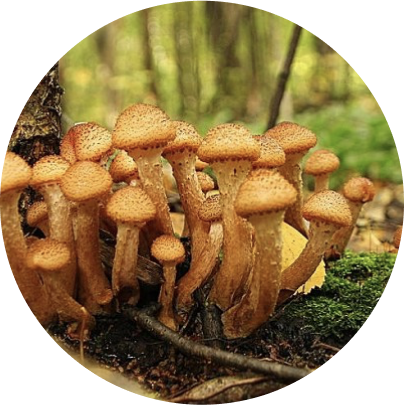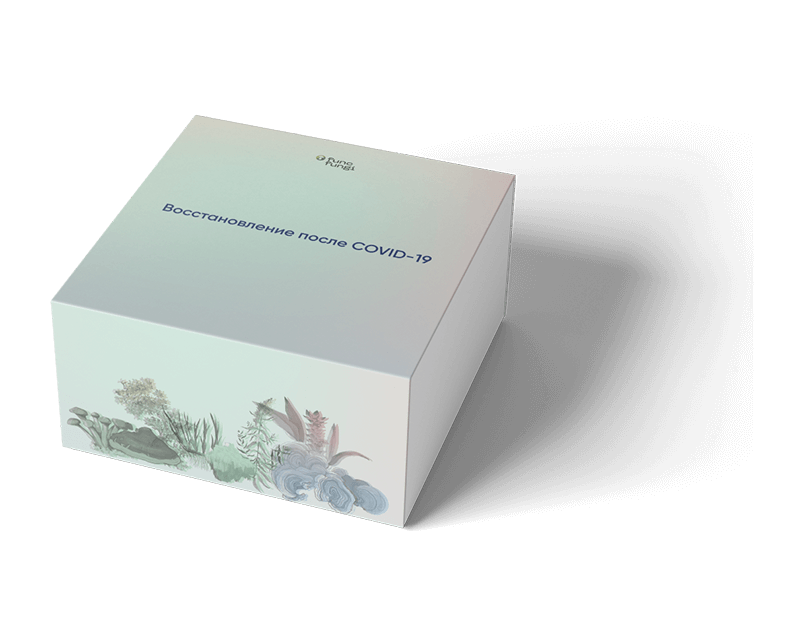Опенок осенний.
Входит в состав банки «Дыхание».
Действие осеннего опёнка во многом аналогично действию чаги. Как и чага, опёнок проявляет антиоксидантные, иммуномодулирующие свойства, полезен при респираторных заболеваниях, гипертонии, заболеваниях ЖКТ и диабете, является канцеростатиком и в целом общим универсальным тоником. Как и чага, осенний опёнок содержит меланины, позволяющие бороться с болезнью Альцгеймера, и действует как антидепрессант. Но, в отличие от чаги, опёнок существенно увеличивает насыщенность крови кислородом и повышает её приток к сердцу и мозгу, то есть берёт на себя работу повреждённых лёгких и даёт им время для восстановления без избыточных нагрузок.
подтверждающих эффективность ингредиента
Вишневский М. В. Лекарственные грибы России. М.: Проспект, 2017.
Въжаров В. Лечебните гъби в България. София: Биана, 2013.
An S. et al. Pharmacological Basis for Use of Armillaria mellea Polysaccharides in Alzheimer's Disease: Antiapoptosis and Antioxidation // Oxid. Med. Cell Longev. 2017. 2017:4184562.
Bohnert M. et al. In vitro cytotoxicity of melleolide antibiotics: structural and mechanistic aspects // Bioorg. Med. Chem. Lett. 2011. 21(7):2003–2006.
Bohnert M. et al. Cytotoxic and antifungal activities of melleolide antibiotics follow dissimilar structure-activity relationships // Phytochemistry. 2014. 105:101–108.
Bohnert M. et al. Melleolides induce rapid cell death in human primary monocytes and cancer cells // Bioorg. Med. Chem. 2014. 22(15):3856–3861.
Chang C. C. et al. Purification, structural elucidation, and anti-inflammatory activity of xylosyl galactofucan from Armillaria mellea // Int. J. Biol. Macromol. 2018. 114:584–591.
Chang W. H. et al. Armillaridin induces autophagy-associated cell death in human chronic myelogenous leukemia K562 cells // Tumour Biol. 2016. 37(10):14291–14300.
Chen Y. J. et al. Induction of apoptosis by Armillaria mellea constituent armillarikin in human hepatocellular carcinoma // Onco. Targets Ther. 2016. 9:4773–4783.
Chi C. W. et al. Therapeutic and radiosensitizing effects of armillaridin on human esophageal cancer cells // Evid. Based Complement. Alternat. Med. 2013. 2013:459271.
Conlon J. M. et al. Characterization of three peptides derived from prosomatostatin [prosomatostatin-(1-63)-, -(65-76)- and -(79-92)-peptides] in a human pancreatic tumour // Biochem. J. 1987. 248(1):123–127.
Geng Y. et al. Anti-inflammatory activity of mycelial extracts from medicinal mushrooms // Int. J. Med. Mushrooms. 2014. 16(4):319–325.
Geng Y. et al. Screening and isolation for anti-hepatofibrotic components from medicinal mushrooms using TGF-(β1-induced live fibrosis in hepatic stellate cells // Int. J. Med. Mushrooms. 2014. 16(6):529–539.
Geng Y. et al. Bioassay-guided fractionation of ethyl acetate extract from Armillaria mellea attenuates inflammatory response in lipopolysaccharide (LPS) stimulated BV-2 microglia // Phytomedicine. 2017. 26:55–61.
Han S. S. et al. Antimetastatic and immunomodulating effect of water extracts from various mushrooms // J. Acupunct. Meridian Stud. 2009. 2(3):218–227.
Huang J. W. et al. [Correlative analysis advance of chemical constituents of Polyporus umbellatus and Armillaria mellea] // Zhongguo Zhong Yao Za Zhi. 2017. 42(15):2905–2914. Chinese.
Kalyoncu F. et al. Antimicrobial and antioxidant activities of mycelia of 10 wild mushroom species // J. Med. Food. 2010. 13(2):415–419.
Lai M. N., Ng L. T. Antioxidant and antiedema properties of solid-state cultured honey mushroom, Armillaria mellea (higher Basidiomycetes), extracts and their polysaccharide and polyphenol contents // Int. J. Med. Mushrooms. 2013. 15(1):1–8.
Lee S. et al. Antigastritis effects of Armillariella tabescens (Scop.) Sing. and the identification of its anti-inflammatory metabolites // J. Pharm. Pharmacol. 2018. 70(3):404–412.
Li Y. P. et al. [Protective effect of Armillaria mellea polysaccharide on mice bone marrow cell damage caused by cyclophosphamide] // Zhongguo Zhong Yao Za Zhi. 2005. 30(4):283–286.
Lin Y. E. et al. Water extract of Armillaria mellea (Vahl) P. Kumm. Alleviates the depression-like behaviors in acute- and chronic mild stress-induced rodent models via anti-inflammatory action // J. Ethnopharmacol. 2021. 265:113395.
Lung M. Y., Chang Y. C. Antioxidant properties of the edible Basidiomycete Armillaria mellea in submerged cultures // Int. J. Mol. Sci. 2011. 12(10):6367–6384.
Muszyńska B. et al. Chemical, pharmacological, and biological characterization of the culinary-medicinal honey mushroom, Armillaria mellea (Vahl) P. Kumm. (Agaricomycetideae): a review // Int. J. Med. Mushrooms. 2011. 13(2):167–175.
Obuchi T. et al. Armillaric acid, a new antibiotic produced by Armillaria mellea // Planta Med. 1990. 56(2):198–201.
Ojemann L. M. et al. Tian ma, an ancient Chinese herb, offers new options for the treatment of epilepsy and other conditions // Epilepsy Behav. 2006. 8(2):376–383.
Sun Y. et al. Structural elucidation and immunological activity of a polysaccharide from the fruiting body of Armillaria mellea // Bioresour. Technol. 2009. 100(5):1860–1863.
Watanabe N. et al. A novel N6-substituted adenosine isolated from mi huan jun (Armillaria mellea) as a cerebral-protecting compound // Planta Med. 1990. 56(1):48–52.
Wu J. et al. A polysaccharide from Armillaria mellea exhibits strong in vitro anticancer activity via apoptosis-involved mechanisms // Int. J. Biol. Macromol. 2012. 51(4):663–667.
Xing X. et al. Do the Main Components of the Sclerotia of Umbrella Polypore Mushroom, Polyporus umbellatus (Agaricomycetes), Correlate with Armillaria Associates? // Int. J. Med. Mushrooms. 2020. 22(5):479–488.
Yan J. et al. Structure elucidation and immunomodulatory activity of a β-glucan derived from the fruiting bodies of Amillariella mellea // Food Chem. 2018. 240:534–543.
Yang S. et al. Polysaccharide-Enriched Fraction from Amillariella Mellea Fruiting Body Improves Insulin Resistance // Molecules. 2018. 24(1):46.
Yang S. et al. Alkali-soluble polysaccharides from mushroom fruiting bodies improve insulin resistance // Int. J. Biol. Macromol. 2019. 126:466–474.
Yong T. et al. Hypouricemic Effects of Armillaria mellea on Hyperuricemic Mice Regulated through OAT1 and CNT2 // Am. J. Chin. Med. 2018. 46(3):585–599.
Zavastin D. E. et al. Armillaria mellea: phenolic content, in vitro antioxidant and antihyperglycemic effects // Rev. Med. Chir. Soc. Med. Nat. Iasi. 2015. 119(1):273–280.
Zhang T. et al. Study on antidepressant-like effect of protoilludane sesquiterpenoid aromatic esters from Armillaria Mellea // Nat Prod Res. 2019. 35(6):1042–1045.

